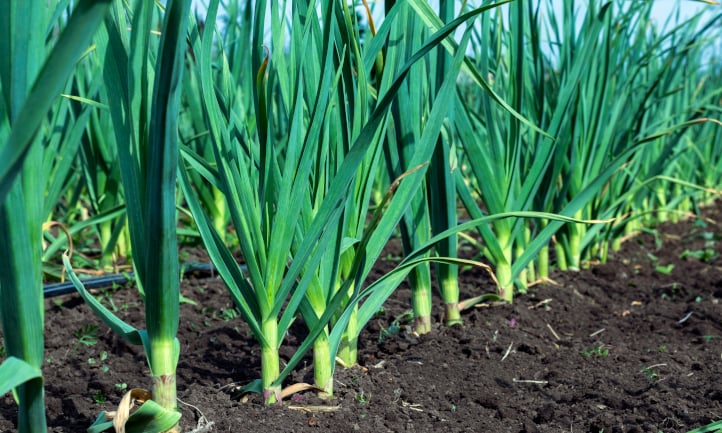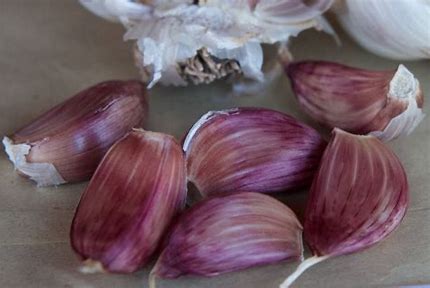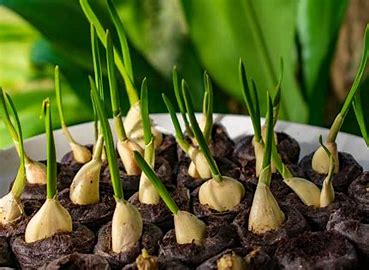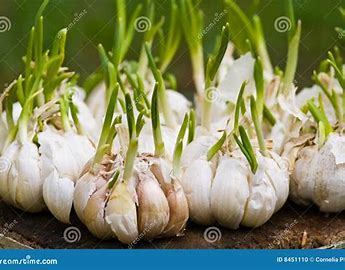
Garlic is not just any old garlic. Many do not know there are two subspecies, Hard Neck and Soft Neck. Understanding the differences between the two is vitally important in choosing the most suitable garlic variety for yourself. The two vary in plant and bulb size, growth, flavour, colour, harvest and storage time and their climate suitability across different parts of Australia. The crazy thing is that with the utter dominance of only Soft Neck garlic available in supermarkets with minimal depth in flavour, we the consumers and cooks have had little exposure, opportunity or choice to use the more stronger and more robust, deeply flavoured Hard Neck in cooking. So, we are missing out big time on flavour and this why it is so important to grow your own. More to that later.
A true sign of garlic’s huge popularity in present day home cultivation is its extraordinarily high level of sales in the nursery I work in. They are close to even eclipsing those of daffodils and tulips. They fly off the shelves quicker than we can replace them. Then the shelves sadly lay bare, barren and empty, until the next long anticipated delivery finally arrives, no matter the volume I order.

A long, long time ago, growing up as a youth in an outback town in Australia I never remember the use of it, not in any dressings, sauces, bakes, curries or stews. It was a strictly English menu, garlic a thing mentioned only in movies to ward off vampires. There was a deli run by Greek family but I never remember my mother shopping there, and one I myself never visited. But then in those days there were no supermarkets either, only corner shops. Today our wholesale adoption of garlic is emblematic of how far we have come to fully embracing international cuisine.
Wild garlic probably originated somewhere in Western Asia and has been around for over 5,000 years. It is one of the oldest cultivated crops in history. Today it is called a super food for its many health benefits and is a mandatory ingredient in most great international cuisines. And most importantly for us gardeners, they are a perfect candidate for companion planting throughout the whole garden. Today there are a huge plethora of cultivars to choose from, from the everyday easy names of Australian Red, Purple and White, to the more exotically and cosmopolitan named varieties such as Marble Blush, Rojo de Castro, Crook Long Neck, Oriental Red and Oriental Purple, Spanish Purple Stripe and El Camino. All these are Hard Neck with the exception of Australian White a Soft Neck. Here is a rundown on the differences between the two.
Hard neck (Allium sativum var. ophioscorodon)
• Rarely if ever sold in grocery or supermarket stores,
• Have a much stronger, complex and robust pungent flavour. They are used in European cuisines adding great depth to dishes such as French, Italian, and Mediterranean.
• Have a stiff, woody neck that produces a central flowering stalk called a scape that is also edible.
• They are best suited for growing in cool climates with a cold winter.
• The bulbs are generally smaller than soft neck bulbs. with larger but fewer garlic cloves. Each bulb usually has 4-12 cloves neatly arranged in a single layer.
• Hard neck bulbs are easier to peel and often have a stunning purple blush.
• Shorter shelf life lasting 5-8 months
• All the before mentioned cultivars available are of the hard neck sub species with only exception the Australian White, which is a soft neck.
Soft Neck (Allium sativum var. sativum)
• Is the type commonly seen on supermarket shelves and thus the variety we are most familiar cooking with.
• Possess a much mild sweeter flavour that gets even better when stored for a few weeks before use. They are ideal for cuisines that need subtle flavouring, for example Asian dishes.
• Have no central flower stem or scape but sports a bendy, braidable stem.
• A longer shelf life lasting 8-12 months
• is less resistant to frost and thus grows best in warm climates
• Produces larger bulbs with each bulb tightly packed with 10-30 cloves of varying sizes. with larger ones on the outside and smaller ones towards the centre.
• Their bulbs and skins are typically cream or white, but some varieties may show a pinkish blush.

Companion Planting
Having a potager I plant the great majority of my garlic, not in a dedicated vegetable bed, but as a companion plant, tightly interplanted en masse amongst my many roses to help deter the spring infestations of aphids. What makes garlic work so well in this case is the sulfur and allicin found in them. The smell of the two combined confuses the aphids’ sensory receptors and thus reduces their ability to be attracted and attack your coveted roses. In this case you need to plant the garlic very shallow, so the tops of the garlic are just exposed above the soil, for it is the cloves, not the green stems which produce the repelling odour. In addition, garlic planted amongst your brassicas such as cabbages and broccoli is very effective, for the garlic reduces and disguises the attracting smell of mustard in their leaves against white butterflies. However, if the aphids have already settled on any of the plants, the method is no longer very promising and thus it is generally considered only as a deterrent or preventive measure. It is the same with the use of garlic sprays commonly available commercially, again only a preventative measure. But every little bit helps if you are a gardener.

Cultivation
• In cold Australian regions, plant hard neck garlic in autumn. This ensures early root growth before the advent of the first frosts. They love cold hard winters. Cloves need around four-eight weeks of cold exposure below 4°C, to trigger bulb growth.
• If you live in a warmer climate, you can begin first by keeping them in the fridge for four-eight weeks before planting to mimic cold weather. This is called vernalisation.
• A well-drained soil is a must to prevent the cloves from rotting away, for they detest wet winters. If you have to live with a clay soil the best alternative is to cultivate them in raised garden beds or in pots and ensure it is of the best top quality.
• Garlic prefers slightly acidic to neutral soil (pH 6.0-7.5).
• Good sun in winter is essential in order to maximise growth.
• Plant each clove 2-3 inches below the soil with the pointed end upward. Plant 3-5 inches apart
• Water the planted cloves to settle the soil and cover with a lightweight mulch such as sugar cane to retain moisture and regulate soil temperature.
The shoots will grow through the mulch.
• They’re usually ready to harvest when about half the leaves have turned yellow and died back, typically 7-9 months after planting.
Happy gardening and have fun,
Regards Ned McDowell.